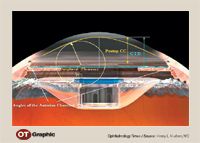Article
Implantable telescope considered safe with good corneal clearance
Safety studies using optical coherence tomography (OCT) to image eyes with a miniature telescope implanted showed that adequate central and peripheral corneal clearance were achieved in these eyes, supporting earlier evidence that the telescope is safe for long-term use. Further studies suggest that OCT also can be used in these patients to detect recurrence of choroidal neovascularization.
Fort Lauderdale, FL-The use of anterior segment imaging with optical coherence tomography (OCT) has shown adequate central and peripheral corneal clearance in eyes of patients who had received an investigational implantable miniature telescope, adding to earlier data showing that this device is safe.
Posterior segment imaging in these eyes also could be valuable in helping detect recurrence of choroidal neovascularization (CNV) and prevent loss of visual acuity in patients with age-related macular degeneration (AMD), according to Henry L. Hudson, MD, who presented a study at the annual meeting of the Association for Research in Vision and Ophthalmology (ARVO).

The IMT002 trial was a prospective, open-label, multicenter clinical trial conducted under an investigational device exemption from the FDA. The telescope was implanted in 206 patients aged 55 or nore years who had bilateral end-stage AMD. According to Dr. Hudson, 1-year data showed a documented benefit in these patients; more than 90% of them gained 2 lines of vision, 67% gained 3 lines, and 25% gained 5 lines.
Dr. Hudson presented data from the additional safety analysis as well as a diagnostic study. While gathering the follow-up data requested by the FDA through anterior segment imaging, Dr. Hudson also decided to use OCT to obtain images of the posterior pole through the telescope to image the posterior segment.
A proprietary imaging system (Visante OCT, Carl Zeiss Meditec) was used for the anterior chamber; the device has a 1,310-nm infrared light that penetrates through sclera and iris and rapidly captures high-resolution images. UBM also was used at several centers, Dr. Hudson reported.
Data for central corneal clearance were available on 45 eyes, and data for peripheral clearance left and right were available from 40 and 39 eyes, respectively. Little difference was seen between preoperative anterior chamber depth and postoperative central corneal clearance. Postoperatively, the central corneal clearance was slightly less, and the deeper the starting chamber, the deeper the central corneal clearance. A trend, but no statistical significance, existed for the relationship between preoperative anterior chamber depth and postoperative central corneal clearance.
Newsletter
Don’t miss out—get Ophthalmology Times updates on the latest clinical advancements and expert interviews, straight to your inbox.




